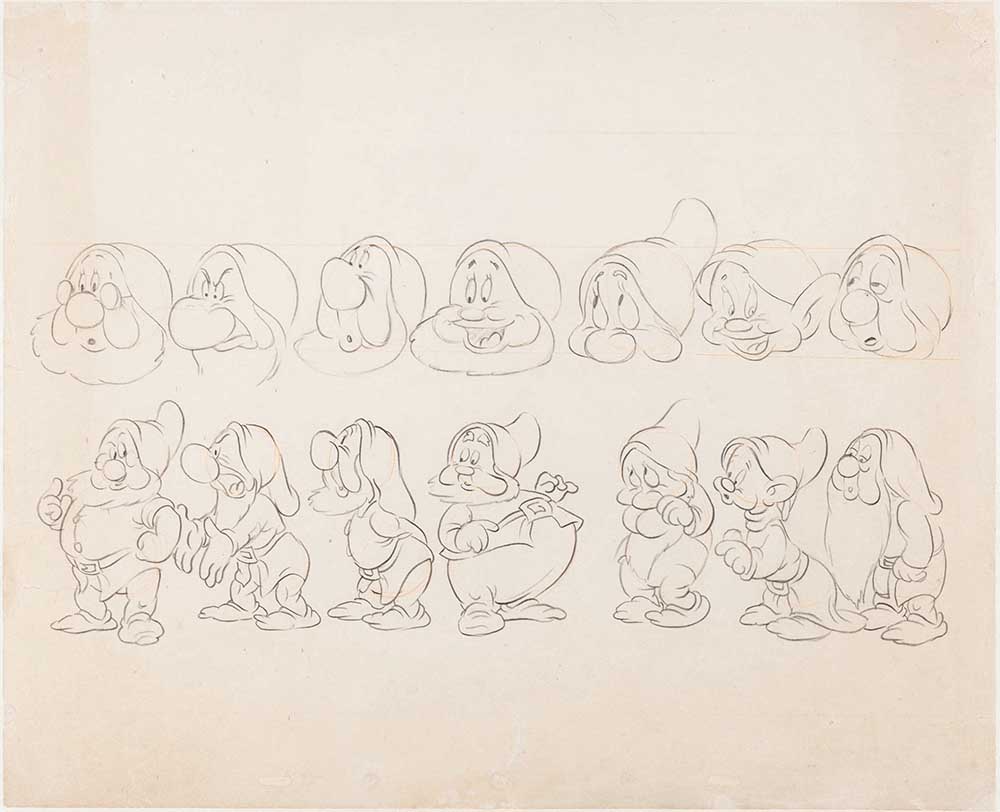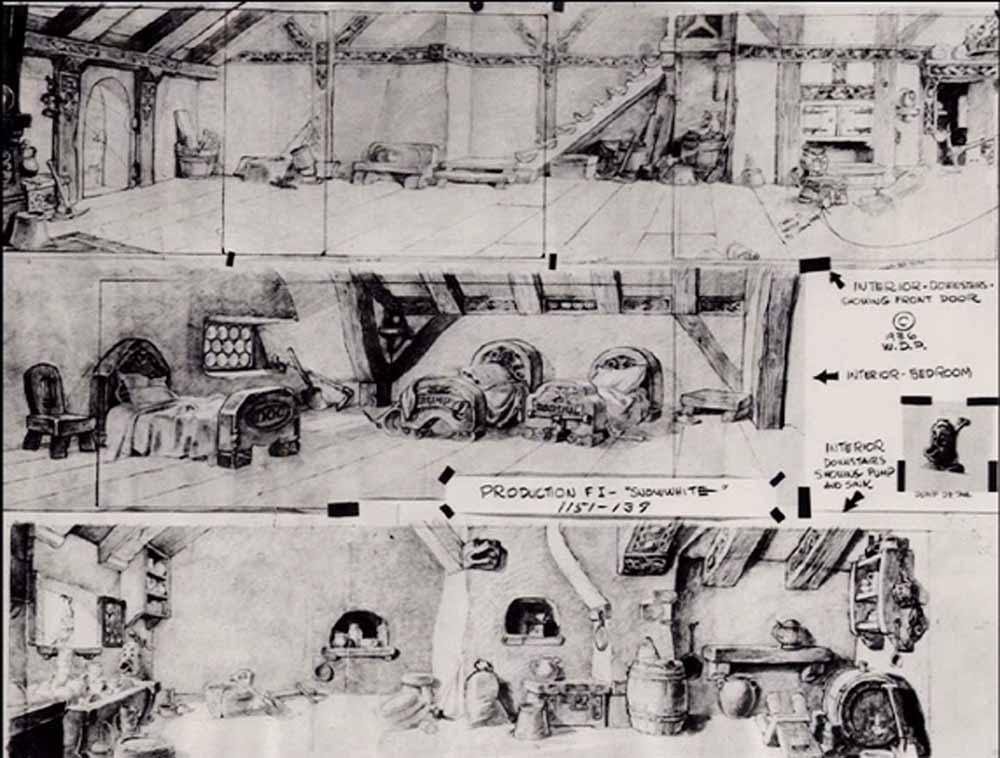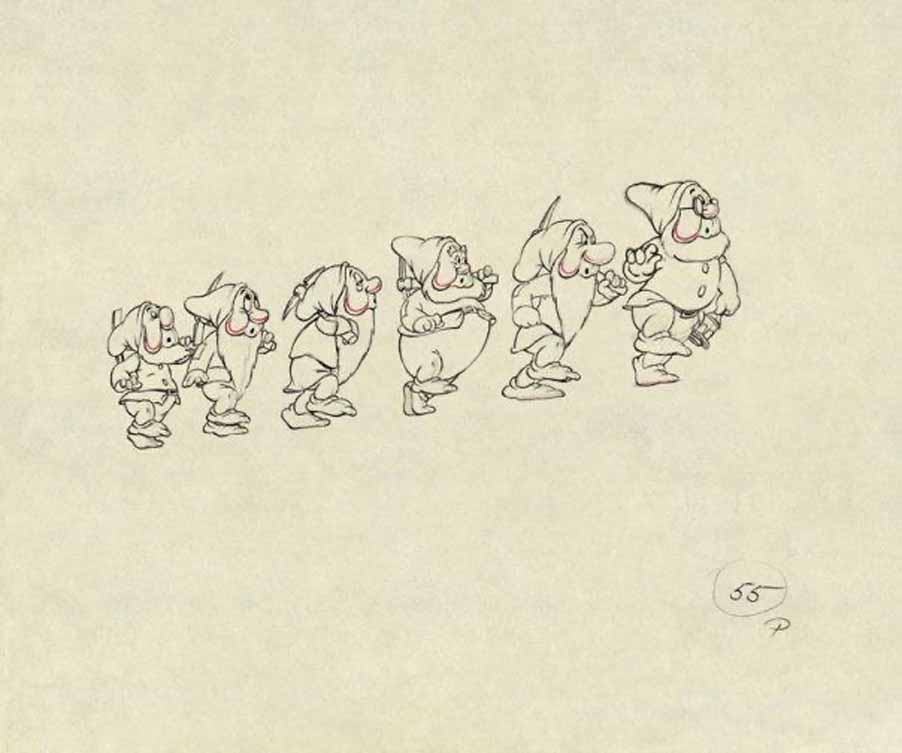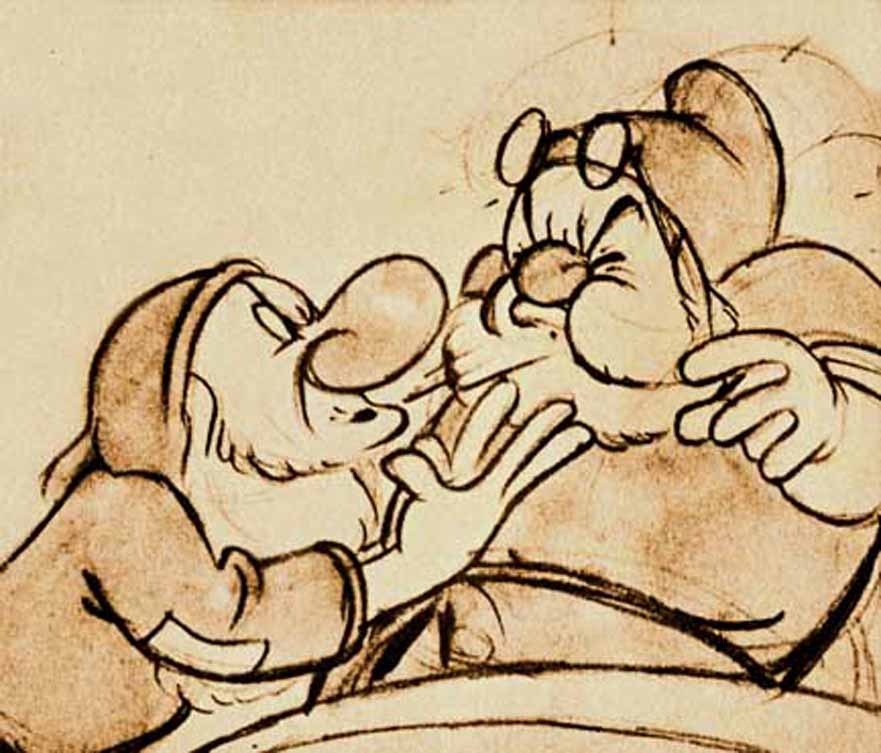Information
Sequence number: 4B, 5A, 6A
Date of document: ?
Date of Meeting: November 10, 1936 (7:30 p.m. – 10:00 p.m.)
Topics covered: Personalities of the seven dwarfs
Meeting participants: Hal Adelquist, Les Clark, Carl Fallberg, Dave Hand, Wilfred Jaxon, Ham Luske, Jack Miller, Fred Moore, Perce Pearce, Bill Shull, Fred Spencer, George Stallings, Terrill Stapp, Riley Tompson, Bill Tytla.
Minute writer: Esther Newell (6 copies)
This meeting, regarding the appearance of the dwarfs, seems to follow the attendance of a screening of live action reference footage with a man referred to as “Major George”, obviously a person with a small physique. Several artists in the same field adopted the nickname “Major” such as Major Mite, or Major Doyle, who respectively acted in The Wizard of Oz, and the Snow White and the Seven Dwarfs show of World of Mirth Shows. I could not, however, locate a “Major George” who may or may not have been George Ministeri who did vaudeville at the time and also acted in The Wizard of Oz, later. However, Eddie Collins, the model for Dopey, and Roy Atwell, the voice of Doc, are also mentioned.
The focus of the discussion is how realistic the dwarfs’ appearance and behavior should be.

DAVE: I would like to get an expression of opinion in regard to whether we should drive toward the human angle of the dwarfs walking, or whether dwarfs should swing fanny from side to side working with their hips.
BILL T: On account of pelvis condition, the dwarfs are inclined to walk with a swing of the body.
DAVE: This fellow (MAJOR GEORGE) is the nearest proportion to a dwarf that we have had. Others have been deformed.
If we knew just what we wanted, we would get just as much out of it by watching them.
FRED S: I don’t think he (MAJOR GEORGE) has what we want. The dwarfs have a waddle.
DAVE: I would like to have an expression of what course to follow to get the dwarfs’ actions.
JAXON: The real dwarfs seem just a little repulsive—a little different from the real thing—too much deformity. Collins gives a better interpretation of the thing. In mimicking him, we would get away from the deformity.
DAVE: I am afraid that if we don’t establish some kind of movement on these dwarfs, we will have a regular walk.
FRED S: We ought to establish a manner of walk, but not to make it look repulsive.
DAVE: I think it would be a good idea to run this picture and pick out the stuff in it that is good and cute and dwarf-like that we can incorporate.
FRED S: Each one will have to have his own distinction.
DAVE: Establish just how they are going to carry themselves.
GEORGE: (Referring to scenes of MAJOR GEORGE’S) On account of his shortness of arms and legs, it handicapped him because he was bellied. There is one particular instance where his arms were stiff when carrying a lantern on account of their shortness. On account of his belly, his arms are made to look stiff.
Do you think the exaggeration on the other dwarfs’ arms will make them look dwarf-like, or do you think the squatty movement is going to be dwarf-like and made to be interesting?
DAVE: We can’t do without short legs and arms. The feeling should be a short arm rather than a long arm. (Major George) His arms were a little short.
FRED: The arms always get a little shorter rather than longer.
BILL T: When waving his arms, he really had not control of the arm. He really ought to do something definite.
HAM: All dwarfs are double jointed, at least it is claimed so.
BILL T: The construction of muscles and pelvis bone prevents these dwarfs from crossing their legs.
PERCE: Major George is very narrow across his pelvis.
DAVE: The leg and fanny action should be studied a great deal.
BILL T: You should have them hop on and off of things,—propel themselves forward—propel themselves up. They should never grab and brace themselves.
DAVE: Have him put his hands on the edge of the barrel, and kind of hop on the barrel. What I want to bring out is that the arms should be shorter rather than longer. If arms are too long, we will lose our dwarfs.
GEORGE: This fellow’s hands are normal size. He could almost fan his whole arm with his hand. There is no movement to manipulate them.
LES: Almost child-like instead of men.
PERCE: You mean they have the mentality of children?
BILL T: It isn’t normal mentality.
HAM L: I think they could be like kid.
DAVE: I think the way they fight each other is child-like,—almost like kids the way they fight.
LES C: There is a child-like thought to their actions.
HAM: I think they ought to be more sprightly,—have a bit of bouncy characteristic,—hopping up and down.
BILL T: They do have dwarf-like characteristics when they do hop up on something,—hop like monkeys. They get their feet under their hands.
DAVE: That is the type of thing we want to get into the picture.
GEORGE: I think that if they want to get up on something that they should slip leg under hand and get up. Use their arms for momentum or something, but at the same time use dwarfs action.
DAVE: I would like to take exception to one thing that I don’t think is true. Only, because we put a pad on him (MAJOR GEORGE) would prevent him from using his arms.
GEORGE S: That is true of all fat men.
DAVE: There is free moving as we depict them. I don’t agree with what we have on the screen,—only with the future.
FRED M: Let’s have these little guys doing some things that are human-like.
HAL: I think of the dwarfs as actually dwarfed persons—that is not normal. I like to see these little guys as though they are like little pigs and be able to do the same things a pig would. I understand that the pygmies in Africa are small in stature and yet have the same facilities as human beings. You wouldn’t want these guys to be something of dwarf characteristic and do things that they won’t get over to the audience.
BILL T: I think it would be a good thing to have the dwarfs react the way a person would understand these things completely. The audience would feel the same way.
FRED M: I think there is something cute about these dwarfs, and in order to keep them cute they should have short arms and legs.


HAM: I think the dwarf’s house should be built in proportion to them,—that is proportionate to their size.
(X): However, S.W. does not come in actual contact with the dwarfs. If she did, she would become a giantess.
DAVE: They are small guys and should have shortened arms and legs and larger head size.
FRED M: I took a half a foot off my arm, and yet they are not startling shorter.
JAXON: The main thing we can bring out is the larger head size—larger than true-sized heads, and yet keep their dwarf-like characteristics that we can.
DAVE: I think it is important for us to pick out some main business on the dwarfs that we can get ahold of so that we can see the movement of arms and legs, and the fanny movement. The whole body is laying forward and fanny sticking out.
FRED M: They would get part of their momentum with shoulders and not wave arms around.
DAVE: Don’t they have a little shorter movement? I think a duck is an excellent basic thing to build from. As the duck walks along, he waddles from side to side.
FRED M: I think we ought to keep these guys in the atmosphere of dwarfs,—(MAJOR GEORGE) elbow doesn’t bend, arm doesn’t swing when it should, etc.
PERCE: Take the stiltedness out of action, but retain that feeling of waddle.
BILL: Retain basic mannerisms in certain types of actions and walks. Otherwise, if you have them go by just reacting phlegmatically, half dumb or undeveloped, for a full-length picture, stuff will drag.
DAVE: Don’t have them imbeciles.
BILL: You have to resort to something more normal in action towards things.
PERCE: We don’t want their actions to be too eccentric and not too much like men. We want something that will add a certain charm to the stuff.
LES: I think we should try and retain the fundamental principles.
What are the basic things we should follow and should stay away from?
DAVE: I would say that if we could get a feeling of basically awkwardness, we might retain a dwarf-like quality.
STAPP: Can he (MAJOR GEORGE) stoop over on the floor and pick something up?
DAVE: He could because he has such a long upper.
GEORGE: He can take hold of his toes and sit down stiff-legged.
A peculiar characteristic of the dwarfs in walking would be to have them put one foot up to the other and turn body sideways.
BILL: If we could get one of the dwarfs in a frame of mind—he is sore—he would walk with the attitude of a person that is mad.
HAM: Seems to me this business is caricature. We have to keep short arms and legs as well as their cuteness. We ought to be able to make him madder and still keep the cuteness in there.
HAM: Have the dwarfs hop up and down, etc. Anything that tightens down on any of those things is wrong.
It would be a good idea to spring up and down in his legs when he walks. (MAJOR GEORGE) You will notice in the picture that he had no spring in his walk on account of his short legs.
DAVE: Perce brings out something here that we might discuss. Perce feels that because of their short legs, we might have a quicker timing on them,—instead of 12, you might use 8. They will be little waddly legs.
Do you think in timing stuff, it should be timed faster, or should it be a normal walk timing?
FRED M: I think you should use a quick little walk, covering the same number of feet you would normally walk, using same speed, same movement of body. Try to work out some kind of a plan where we get away from the old pattern to cover ground.
HAM: Take Dopey’s walk, for instance,—he could walk with his shuffling with his toes out looking around, etc.—and get in variation of long steps with one fellow.
GEORGE: That is what I was talking about yesterday on the timing action of the short steps. As he walked, his feet were dragging.
In taking the characteristic walks of the dwarfs, I don’t think Sleepy could walk as fast. He is much slower.
DAVE: There is one exception,—and that is that he should walk like the rest.
If you walk a normal-sized character with a dwarf across the room,—say in 2 feet, the dwarf would get there just as quickly as the normal character, with the exception that the dwarf would use quicker steps.
FRED S: Kind of a semi-run.
PERCE: It has a little hustle to it. It will throw a sprightly feeling in the sense that it might appear draggy.
GEORGE S: In comparing a normal walk with dwarf, the dwarf would take many more steps to reach the same distance.
JAXON: If you had a normal-proportioned fellow playing the part of Sleepy, ordinarily he would not move his body as fast as the others would. It would step Sleepy down. He would be much slower in proportion. He would still take same number of steps, but drag along. You get your Sleepy character among the dwarfs in relation to the dwarfs in the way they move.
DAVE: Keep him in step but don’t use him in extreme.
GEORGE: Keep him in step and his legs moving,—the upper portion of his body rather dragged out.
DAVE: Contrast Sleepy and the other dwarfs. No matter what tempo of step, Sleepy keeps in tempo in step, but not extremed to waddle and bouncing. Don’t try to break him out of step.
BILL: The correct attitude of the dwarfs walking through the forest would be—Happy would be bouncing around, Grumpy would be dragging himself, Sleepy, keeping step, but draggy, etc.
HAL: Don’t you think it would be more enlightening if we would take the character-like pose and characteristics of each dwarf, and know what we have in each one.


FRED: All our dwarfs are constructed about the same, generally speaking.
DAVE: Fred brings out a point that the dwarfs sit down and never drop their legs. They never hit the floor. Rather keep them out straight.
BILL: If what they are sitting on would allow for it, if they sit on enough of the chair, it would give them a brace so that their legs would be straight out.
DAVE: Ordinarily these dwarfs would move with a normal step, but in order to contrast them, we will have to move those feet at faster tempo, or we will not get the dwarf-like quality.
BILL: Their build would be to walk slowly.
JAXON: Present dwarfs to audience in contrast to what they are seeing.
GEORGE: Use same body action as you have, but each body action different.
DAVE: The audience is used to seeing dwarfs keep up with human beings.
PERCE: Suppose the dwarf is dejected, we want to walk him along sloppily—tendency being for him to waddle along. The dwarf would put in more steps than a long-legged character would. We would still get a contrast if we wanted the guy to walk along slowly.
The dwarf music is carried along in sort of sprightly, rushed tempo.
HAM: You have Happy’s music, sad music. The dwarfs are happy creatures three-quarters of the time. I would suggest that you have a fast tempo. If you have slow tempo, the dwarfs would move slowly as anyone else would. Dwarfs when moving from one place to another, someway move in a faster tempo. Dwarfs walking side by side would both have the same body movement.
GEORGE: If you came walking down the street, walking normally but with long strides, the dwarf would naturally have to quicken his steps in order to keep up with you and at the same time hold in his extremes. As the dwarfs walk fast, you get a light feeling.
BILL: What would be the normal rhythm?
FRED: The rhythm of the dwarfs is rather sprightly music.
DAVE: I feel that the dwarfs should have a faster tempo in walking so that we could move him in and across the screen. He might have to work a little harder to get to the place where he is going, but his legs would move at a faster tempo.
JAXON: In contrasting a woman walking along with a dwarf, I have never seen (dwarfs) them galloping along trying to keep up with anybody else. I advise doing everything in that particular tempo. In order to make them appear or seem like dwarfs, we have to make a contrast.
BILL: Contrast them in the way they are built rather than the way they walk.
JAXON: Whether it is correct or not, it is better staging to cheat on them—get a sprightly, quick little movement. It will be cuter.
FRED S: For instance, in the scene, MARCHING HOME FROM THE MINE, would you have them walking sprightly? I wouldn’t. They are tired after their day’s work.
DAVE: If there was a scared feeling among them, the feet would quicken almost to a run—quite fast. If there was a feeling of anger, the walk would be more of a normal walk.
BILL: The dwarfs have created a world of their own and are in a relaxed state of mind, why should they be hustling around.
GEORGE: What is your comparison?
DAVE: There is no comparison.
GEORGE: Then I would see them moving at a very active movement with the exception of my scene. Those fellows are marching at a very snappy movement.
DAVE: I think in as much as we have had a thorough discussion of it and we have an idea in our minds as to what we would like to see that it should be taken up with Walt. It will have to be done soon, because we are moving them. Take Dopey, for instance, when he runs out—would he run out like a normal person or would he waddle out?
There are more in favor of the quicker little movements than the normal step.
LES: I think this is controlled a great deal by the structure of each individual. You have to make them fit their mood.
DAVE: Based in normal movement compared to size.
FRED: Picture these guys in the mine—if a normal person took three steps these little guys would take six steps in the same length of time.
DAVE: If we timed it for 3′ normally, they would get there in 3′ even though it would necessitate more steps.
BILL: In other words you are laying out everything to a normal size and have a little dwarf cover it,—Where you have a house of normal size, and everything inside the house is built to suit the size of the dwarfs. I think everything should be cut down to scale.
A normal person would take three steps at a time and dwarf would have to cover each step.
JAXON: This should be staged in proportion and contrast in size. A giant would lay out a house in proportion to himself.
DAVE: We have a great distance to cover in a normal rate of speed with normal rate of character.
BILL: For instance, we want the dwarfs to do personality stuff, action on their toes. You want to get them on their toes—unless you get them to fly. There is no element of contrast. You lose contrast by making them step up to things.
DAVE: We only want a sprightly, lively feeling to them.
CONTRASTING DOC AND GRUMPY
Doc, Grumpy, and Dopey are three main characters; others are more or less in the background.
DAVE: Doc’s arms seem pretty short.
FRED S: I think they could be more restricted.
DAVE: It would give more of a dwarf feeling in the movement.
FRED: I think his arm movement could come up part way instead of covering his face.
DAVE: What do you think we should pick out in contrasting Grumpy and Doc?
PERCE: I tell you in the scene where Doc and Grumpy are arguing would show contrasting personality of these two. This scene is typical aside from animation, of the type of thing we have between these two characters in various spots of the picture. Where Grumpy incites Doc to say something that he really doesn’t mean,—he gets out—Grumpy puts him back by feeding him the wrong word; he picks up again and then comes out of it. The hand action of Doc here, fighting in and out of words in the dialogue. This is very typical of these two characters. We are approaching the feeling pretty well here.
All through this mixed-up dialogue of Atwill’s, constantly, you have that UH! UH! and the shaking of the head getting in and out of the mistake. He finishes, tries for a fresh start. Every time he gets mixed up, he tries to shake himself out of it.


FRED: I would like to bring out the idea that Grumpy is more sure than Doc, and he is the type of person that burrows under Doc, and Doc has to lead back.
JAXON: Grumpy pokes his nose in Doc’s face.
DAVE: Grumpy is very aggressive at all times.
HAL: Show Doc’s personality. Whenever Grumpy has the floor, he always has a pleased expression unless he gets crossed.
PERCE: This also shows one of Doc’s weaknesses, his susceptibility to the other guy. This guy can throw him into a mood which he regrets he’s in.
Bashful is going to have big brown eyes and eyelashes with a long beard.
Happy is going to have a short beard.
This close-up scene of Doc’s brings out a good part of pantomime.
He takes off his glasses, which is very typical of an old, pompous guy. Putting on his glasses and then squinting over them at the other guys.
Then as we truck away to the longer shot of the action of Doc’s, we come onto the group. Doc puts over the feeling of boss in this scene.
JAXON: Doc’s hands are not fluttering when he knows what he is going to do.
PERCE: There you have a chance to get a contrast, putting over a plain feeling into what he is doing—by contrast—as well as a chance to treat his hands in a determined way as to put over against his normal decision.
Watch double shake he gets into Doc and the way he handles loose jowls.JAXON: The jowls sort of pull back.
